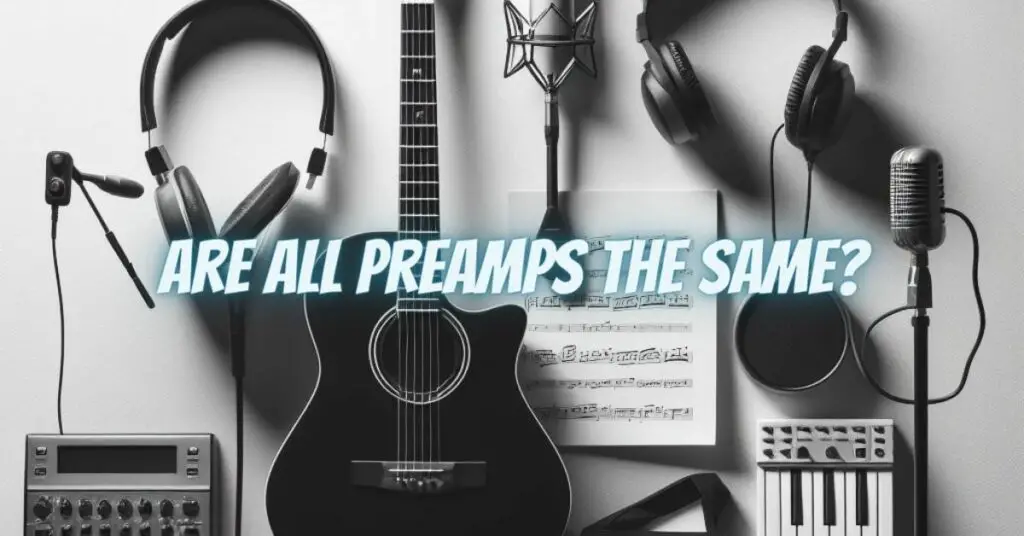In the intricate realm of audio engineering, preamps often stand as unsung heroes, quietly shaping the sonic foundation of music production and live performances. While power amplifiers provide the muscle to drive speakers, preamps play a crucial role in amplifying, shaping, and coloring the delicate signal from microphones or instruments, imbuing the sound with warmth, clarity, and definition. However, a common question arises among audiophiles and musicians alike: are all preamps the same?
The Essence of Preamplification: Elevating the Signal
At its core, a preamplifier serves as a signal booster, taking the weak electrical signal from a microphone or instrument and amplifying it to a level suitable for driving a power amplifier or directly connecting to recording equipment. This amplification process is essential for ensuring that the signal is strong enough to be heard above the accompaniment and other instruments.
Beyond Amplification: Shaping the Tonal Palette
While amplification is the primary function of a preamp, it also plays a significant role in shaping the overall tonal character of the sound. Preamps often incorporate equalization controls that allow for adjusting the balance of frequencies in the signal, enhancing or reducing specific areas to achieve the desired sonic outcome. Additionally, some preamps feature onboard effects, such as reverb and compression, that can add depth, dimension, and polish to the sound.
Exploring the Variations in Preamp Design and Performance
While all preamps fulfill the fundamental function of amplifying and shaping the signal, they differ significantly in their design, circuitry, and sonic characteristics. These variations can be attributed to several factors:
-
Tube vs. Solid-State: Tube preamps are known for their warm, rich, and responsive tone, favored by blues, rock, and jazz musicians. Solid-state preamps offer a versatile range of sounds, from clean tones to heavy distortion, and are known for their reliability and affordability.
-
Discrete vs. Integrated Components: Discrete preamps utilize individual transistors or tubes for each stage of amplification and signal shaping, while integrated preamps use compact integrated circuits. Discrete preamps often offer more nuanced control over the signal, while integrated preamps provide a more streamlined and cost-effective solution.
-
Transformer vs. Transformerless: Transformer-based preamps utilize transformers to isolate the signal input from the power supply, reducing noise and potential ground loops. Transformerless preamps offer a smaller form factor and lower cost, but may be more susceptible to noise interference.
The Impact of Preamp Choice on Sonic Expression
The choice of preamp can have a profound impact on the overall sound of a recording or live performance. Different preamps impart their unique tonal character to the signal, influencing the warmth, brightness, and overall sonic personality. For instance, a tube preamp may enhance the richness of a vocalist’s voice, while a solid-state preamp may emphasize the clarity and punch of a guitar solo.
Discerning the Right Preamp for Your Sonic Vision
Selecting the appropriate preamp depends on several factors, including:
-
Genre and Playing Style: Consider the desired sonic aesthetic of your genre or playing style. Tube preamps are often preferred for blues, rock, and jazz, while solid-state preamps offer versatility across genres.
-
Instrument or Microphone Compatibility: Ensure the preamp’s input impedance is compatible with the intended source, whether it’s a guitar, microphone, or line-level signal.
-
Tonal Preferences: Evaluate the preamp’s tonal characteristics and select one that complements your desired sound.
-
Additional Features: Consider features like onboard effects, multiple channels, and connectivity options.
-
Budget: Determine a realistic budget and consider the value proposition of each preamp within your price range.
Preamps are not simply signal boosters; they are sonic sculptors, shaping the tonal foundation of music production and live performances. By understanding the differences between preamp types, exploring their tonal characteristics, and considering the factors influencing preamp selection, musicians, engineers, and audiophiles can make informed decisions that elevate their audio experiences and unleash the full potential of their sonic endeavors. Whether crafting intricate studio recordings or igniting the energy of a live performance, the right preamp can transform a signal into a captivating sonic tapestry, imbued with warmth, clarity, and the essence of the music itself.


